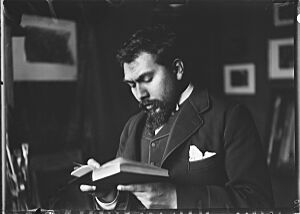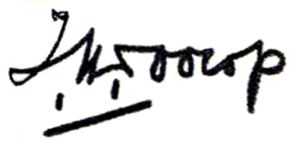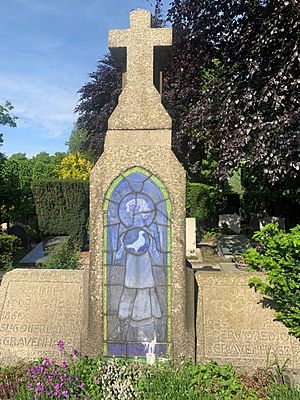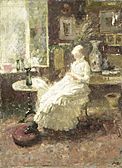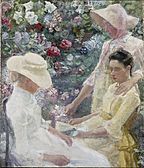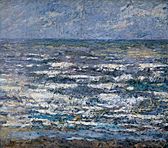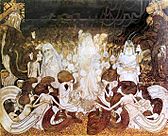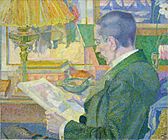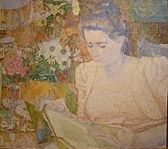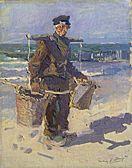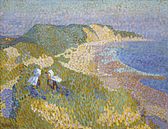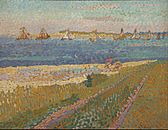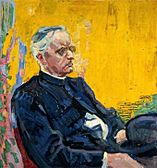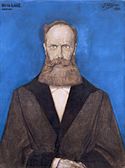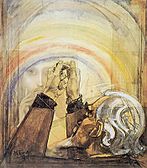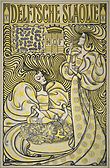Jan Toorop facts for kids
Quick facts for kids
Jan Toorop
|
|
|---|---|

Jan Toorop in c. 1920–1923
|
|
| Born |
Johannes Theodorus Toorop
20 December 1858 Poerworedjo, Dutch East Indies
|
| Died | 3 March 1928 (aged 69) |
| Education | Rijksakademie |
| Known for | Painting |
| Movement | Les XX |
Jan Toorop (born Johannes Theodorus Toorop, 1858–1928) was a famous Dutch-Indonesian painter. He was known for using many different art styles, like Symbolism, Art Nouveau, and Pointillism. His first paintings were similar to Amsterdam Impressionism.
Contents
Biography of Jan Toorop
Early Life and Education
Jan Toorop was born on December 20, 1858. His birthplace was Purworejo on the island of Java, which was then part of the Dutch East Indies (now Indonesia). His father, Christoffel Theodorus Toorop, worked for the government. His mother was Maria Magdalena Cooke.
Jan was the third of five children. He lived on Bangka near Sumatra until he was nine years old. After that, he went to school in Batavia on Java.
In 1869, Jan moved from Indonesia to the Netherlands. There, he continued his studies in Delft and Amsterdam. In 1880, he became a student at the Rijksakademie in Amsterdam, a well-known art academy.
Developing His Art Style
In 1883, Jan Toorop met the Belgian painter William Degouve de Nuncques. They became good friends and even shared an art studio for a while. From 1882 to 1886, Jan lived in Brussels. During this time, he joined a group of artists called Les XX (Les Vingts), which included the famous artist James Ensor.
While in Brussels, Toorop explored many different art styles. These included Realism, Impressionism, Neo-Impressionism, and Post-Impressionism.
Symbolism and Family Life
In 1886, Jan Toorop married Annie Hall, who was from Britain. After their marriage, Jan spent his time between The Hague, England, and Brussels. After 1890, he also spent time in the Dutch seaside town of Katwijk aan Zee.
During this period, Jan Toorop developed his unique Symbolist art style. This style used dynamic, unpredictable lines. These lines were often inspired by Javanese patterns. His Symbolist paintings often featured tall, slender figures and curvy designs.
Life in Domburg and Later Styles
In 1897, Jan Toorop moved to a small house in Domburg, a seaside town in Zeeland. He lived there for 20 years. He worked with other artists in Domburg, like Marinus Zwart and Piet Mondrian. Even though they worked together, each artist had their own style. They found inspiration in the special light of Zeeland, its dunes, forests, beaches, and the local people. Toorop was a central figure among these artists.
Around 1900, Toorop painted a portrait of his friend Marie Jeanette de Lange. This painting was done in the Pointillism style, which uses small dots of color.
Later, Jan Toorop started working in Art Nouveau styles. This style also used flowing lines for decoration. In 1905, he became a Catholic and began creating religious artworks. He also designed illustrations for books, posters, and stained glass windows.
Throughout his life, Toorop also painted many portraits. These portraits varied in style, from very realistic to more impressionistic.
Jan Toorop passed away on March 3, 1928, in The Hague, Netherlands. His daughter, Charley Toorop (1891–1955), also became a painter. His grandson, Edgar Fernhout, was also an artist.
Public Collections of Jan Toorop's Art
Many public art collections display works by Jan Toorop. Some of these include:
- Museum de Fundatie, Zwolle, Netherlands
- Kröller-Müller Museum
Works by Jan Toorop
See also
 In Spanish: Jan Toorop para niños
In Spanish: Jan Toorop para niños


